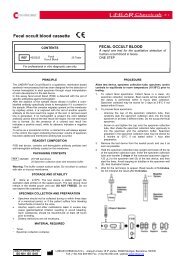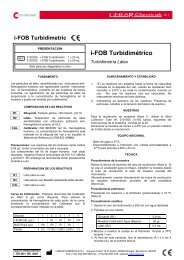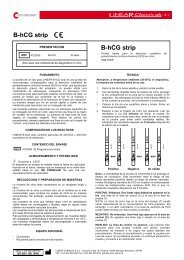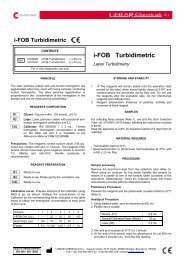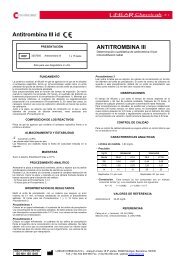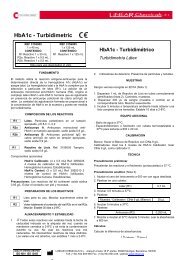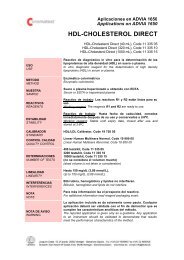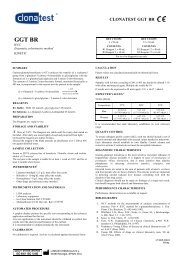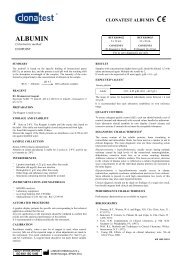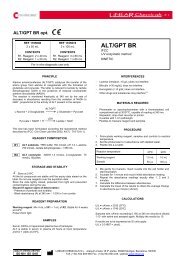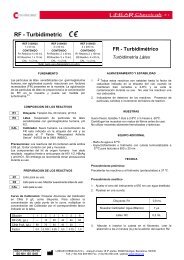Microalbumin – Turbidimetric - Linear
Microalbumin – Turbidimetric - Linear
Microalbumin – Turbidimetric - Linear
Create successful ePaper yourself
Turn your PDF publications into a flip-book with our unique Google optimized e-Paper software.
<strong>Microalbumin</strong> <strong>–</strong> <strong>Turbidimetric</strong><br />
REF 3150005<br />
1 x 50 mL<br />
CONTENTS<br />
R1.Reagent 1 x 40 mL<br />
R2.Reagent 1 x 10 mL<br />
CAL. 1 x 1 mL<br />
For in vitro diagnostic use only<br />
<strong>Microalbumin</strong> - <strong>Turbidimetric</strong><br />
Latex Turbidimetry<br />
PRINCIPLE<br />
Latex particles coated with specific antibodies anti-human<br />
albumin are agglutinated when they react with samples that<br />
contain albumin. The latex particles agglutination is<br />
proportional to the concentration of the albumin in the<br />
sample and can be measured by turbidimetry. 1-3<br />
REAGENTS COMPOSITION<br />
R1 Diluent. Glycin buffer, 100 mmol/L, pH 10.0.<br />
R2<br />
CAL<br />
Latex. Latex particles coated with goat IgG antihuman<br />
albumin, pH 8.2.<br />
Calibrator. Human albumin. Albumin concentration<br />
is stated on the label vial and it is traceable to the<br />
Certified Reference material BCR 470 (IRMM).<br />
Precautions: The reagents contain sodium azide 0.95 g/L.<br />
Avoid any contact with skin or mucous.<br />
The reagents from human donors have been given negative<br />
results to anti-HIV 1/2, HBsAg and anti-HCV. Handle<br />
cautiously is recommended.<br />
MATERIAL REQUIRED<br />
- Thermostatic bath at 37ºC.<br />
- Spectrophotometer or photometer thermostatable at 37ºC with<br />
a 540 ± 20 nm filter.<br />
PROCEDURE<br />
Preliminary Procedure<br />
Prewarm the working reagent and the photometer (cuvette holder)<br />
to 37 ºC.<br />
Analytic Procedure<br />
1. Using distilled water zero the instrument at 540 nm.<br />
2. Pipette into a cuvette:<br />
Sample / Calibrator 7 µL<br />
Working Reagent<br />
1.0 mL<br />
R1<br />
REAGENT PREPARATION<br />
Ready to use.<br />
3. Mix well and record the absorbances inmediately (A 1 ) and<br />
2 minutes (A 2 ) after the sample addition.<br />
R2<br />
CAL<br />
Ready to use. Mix gently the vial before use.<br />
Ready to use.<br />
Working reagent. Swirl the latex vial before use. Mix Latex<br />
and Diluent in a 1:5 ratio (i.e. 2 mL R2 + 8 mL R1) prior to<br />
use.<br />
Calculation<br />
(A 2 -A 1 ) sample<br />
——————— x CAL conc. = mg/L albumin<br />
(A 2 -A 1 ) calibrator<br />
QUALITY CONTROL<br />
STORAGE AND STABILITY<br />
1. The reagents will remain stable until the expiration<br />
date printed on the label, when stored tightly closed at<br />
2-8ºC and contaminations are prevented during their<br />
use. Do not use the reagents after the expiration date.<br />
2. Working reagent is stable during 7 days at 2-8 ºC.<br />
Shake gently the vial before use.<br />
3. Reagent deterioration: Presence of particles and turbidity.<br />
SAMPLES<br />
Fresh urine. It is recommended to adjust the pH at 7.0 with<br />
NaOH 1 mol/L. Stable 7 days at 2-8ºC when sodium azide 1<br />
g/L is added to prevent contamination.<br />
Urine should be centrifuged before testing.<br />
Controls are recommended to monitor the performance of<br />
manual and automated assay procedures. It is recommended<br />
to use <strong>Microalbumin</strong>-<strong>Turbidimetric</strong>-Control (ref: 3945010).<br />
Each laboratory should establish its own Quality Control<br />
scheme and corrective actions if controls do not meet the<br />
acceptable tolerances.<br />
REFERENCE VALUES 7<br />
Adults: Up to 15 mg/L.<br />
Each laboratory should establish its own reference range.<br />
QUALITY SYSTEM CERTIFIED<br />
ISO 9001 ISO 13485<br />
LINEAR CHEMICALS S.L. Joaquim Costa 18 2ª planta. 08390 Montgat, Barcelona, SPAIN<br />
Telf. (+34) 934 694 990 Fax. (+34) 934 693 435. website www.linear.es
CLINICAL SIGNIFICANCE 4-6<br />
<strong>Microalbumin</strong>uria is an increased urinary albumin excretion<br />
(UAE) in the range of 20 to 200 µg/min (or 30-300 mg/24h) as<br />
a consecuence of changes in glomerular permeability 7 .<br />
Increased UAE precedes and is highly predictive of diabetic<br />
nephropathy, end-stage renal disease, and proliferative<br />
retinopathy in type 1 diabetes. In patients with type 2<br />
diabetes, increased UAE is an independendent predictor of<br />
progressive renal disease, atherosclerotic disease, and<br />
cardiovascular mortality. In fact, microalbuminuria may show<br />
to be a risk factor of cardiovascular disease among<br />
otherwise apparently healthy people.<br />
ANALYTICAL PERFORMANCE<br />
- <strong>Linear</strong>ity limit.Up to 160 mg/L, under the described<br />
assay conditions. Samples with higher concentrations<br />
should be diluted 1/5 en ClNa 9 g/L and retested again.<br />
- Detection limit. Values less than 0.78 mg/L give nonreproducible<br />
results.<br />
- Analytical sensitivity. 5.64 mA /mg albumin/L.<br />
- Prozone effect. Up to 1000 mg/L.<br />
- Precision:<br />
Intra-assay<br />
N = 10<br />
Inter-assay<br />
N = 10<br />
Mean (mg/L) CV (%)<br />
8.8 5.9<br />
40.6 2.1<br />
60.8 1.6<br />
8.7 6.1<br />
40.6 2.8<br />
60.8 3.9<br />
3. Do not re-use plastic cuvettes, as they may produce erroneous<br />
values. Use a new cuvette for each microalbumin assay.<br />
4. Clinical diagnosis should not be made on findings of a single<br />
test result, but should integrate both clinical and laboratory<br />
data.<br />
BIBLIOGRAPHY<br />
1. Cambiaso CL, Collet-Cassart D, Lievens M. Clin Chem 34(2) : 416<br />
(1988).<br />
2. Medcalf EA, Newman DJ, Gorman EG, Price CP. Clin Chem 36(3):<br />
446 (1990).<br />
3. Bernard A, Lauwers R. J Clin Chem Clin Biochem 21(1): 25 (1999).<br />
4. Feldt-Rasmussen B et al. J Diab Comp 8 :137 (1994).<br />
5. Marre M, Bouhanich B, Berrut G. Current Opinion in Nephrology and<br />
Hypertension 3:558 (1994).<br />
6. Bar J, Hod M, Erman A, Friedman S, Ovadia Y. Diabetic Medecine<br />
12: 649 (1995).<br />
7. Tietz Textbook of Clinical Chemistry, 3 rd Ed. Burtis CA, Ashwood ER.<br />
WB Saunders Co., (1999).<br />
8. Young DS. Effects of drugs on clinical laboratory tests. 3th ed. AACC<br />
Press (1997).<br />
- Accuracy. Results obtained with this reagents did not<br />
show systematic differences when compared with<br />
commercial reagents of similar characteristics. Details of<br />
comparison are available on request.<br />
- Interferences. Bilirubin (10 mg/dL), hemoglobin (12 g/L),<br />
urea (100 mg/L) and creatinine (300 mg/L), do not<br />
interfere. Other substances may interfere 8 .<br />
NOTES<br />
1. This method may be used with different instruments.<br />
Any application to an instrument should be validated to<br />
demonstrate that results meets the performance<br />
characteristics of the method. It is recommended to<br />
validate periodically the instrument. Contact to the<br />
distributor for any question on the application method.<br />
2. The linearity limit depends on the sample/reagent ratio,<br />
as well as the analyzer used. It will be higher by<br />
decreasing the sample volume, although the sensitivity<br />
of the test will be proportionally decreased.<br />
T3150-1/0106<br />
R1.ing<br />
QUALITY SYSTEM CERTIFIED<br />
ISO 9001 ISO 13485<br />
LINEAR CHEMICALS S.L. Joaquim Costa 18 2ª planta. 08390 Montgat, Barcelona, SPAIN<br />
Telf. (+34) 934 694 990 Fax. (+34) 934 693 435. website www.linear.es



